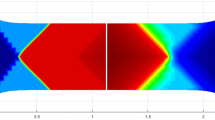Abstract
Fiber reinforced polymer (FRP) composites exhibit nonlinear and hyperelastic characteristics under finite deformation. This paper investigates the macroscopic hyperelastic behavior of fiber reinforced polymer composites using a micromechanical model and finite deformation theory based on the hyperelastic constitutive law. The local stress and deformation of a representative volume element are calculated by the nonlinear finite element method. Then, an averaging procedure is used to find the homogenized stress and strain, and the macroscopic stressstrain curves are obtained. Numerical examples are given to demonstrate hyperelastic behavior and deformation of the composites, and the effects of the distribution pattern of fibers are also investigated to model the mechanical behavior of FRP composites.
Similar content being viewed by others
References
DeBotton G, Hariton I, Socolsky E A. Neo-Hookean fiber-reinforced composites in finite elasticity. Journal of the Mechanics and Physics of Solids, 2006, 54: 533–559
Guiot B, Nadot-Martin C, Dragon A. Towards a non-linear micromechanics-based analysis for particulate composites. Composites Science and Technology, 2006 ( to appear)
Milani A S, Nemes J A. An intelligent inverse method for characterization of textile reinforced thermoplastic composites using a hyperelastic constitutive model. Composites Science and Technology, 2004, 64: 1565–1576
Guz I A, Herrmann K P. On the lower bounds for critical loads under large deformations in non-linear hyperelastic composites with imperfect interlaminar adhesion. European Journal of Mechanics A/Solids, 2003, 22: 837–849
Castañeda P P. Second-order homogenization estimates for nonlinear composites incorporating field fluctuations: I-Theory. Journal of the Mechanics and Physics of Solids, 2002, 50: 737–757
Lopez-Pamies O, Castañeda P P. Second-order estimates for the large-deformation response of particle-reinforced rubbers. Mecanique, 2003, 331: 1–8
Lahellec N, Mazerolle F, Michel J C. Second-order estimate of the macroscopic behavior of periodic hyperelastic composites: theory and experimental validation. Journal of the Mechanics and Physics of Solids, 2004, 52: 27–49
Yin H M, Sun L Z, Chen J S. Micromechanics-based hyperelastic constitutive modeling of magnetostrictive particle-filled elastomers. Mechanics of Materials, 2002, 34: 505–516
Pruchnicki E. Overall properties of thin hyperelastic plate at finite strain with edge effects using asymptotic method. International Journal of Engineering Science, 1998, 36: 973–1000
Li M, Tucker III C L. Modeling and simulation of two-dimensional consolidation for thermoset matrix composites. Composites: Part A, 2002, 33: 877–892
Dubouloz-Monnet F, Mele P, Alberola N D. Glass fibre aggregates: consequences on the dynamic mechanical properties of polypropylene matrix composites. Composites Science and Technology, 2005, 65: 437–443
Yang Q S, Becker W. A comparative investigation of different homogenization methods for prediction of the macroscopic properties of composites. Computer Modeling in Engineering & Science, 2004, 6(4): 319–332
Yang Q S, Qin Q H. Modelling the effective elasto-plastic properties of unidirectional composites reinforced by fibre bundles under transverse tension and shear loading. Materials Science and Engineering A, 2003, 344: 140–145
Author information
Authors and Affiliations
Corresponding author
Rights and permissions
About this article
Cite this article
Yang, Q., Xu, F. Numerical modeling of nonlinear deformation of polymer composites based on hyperelastic constitutive law. Front. Mech. Eng. China 4, 284–288 (2009). https://doi.org/10.1007/s11465-009-0067-0
Received:
Accepted:
Published:
Issue Date:
DOI: https://doi.org/10.1007/s11465-009-0067-0




